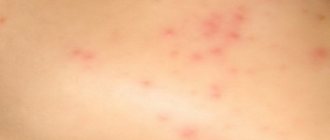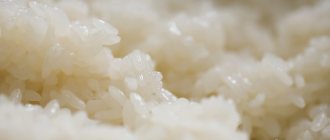Causes of milk allergy
Milk allergy refers to diseases in which the immune system treats proteins and lactose as hostile agents. When they appear, it releases antibodies to destroy them, resulting in an allergic reaction. Allergy to milk protein occurs for a number of reasons:
- immunodeficiency;
- abnormal course of pregnancy;
- hereditary factors;
- presence of parasites;
- the presence of bad habits;
- poorly thought out nutritional schedule;
- professional risks.
If a reaction to cow's milk protein occurs, cross-allergy is possible. A similar effect is possible when eating beef, cottage cheese, cheese, fermented milk or a number of other products that contain a similar protein. The severity depends on the number and similarity of protein components.
What in milk provokes an allergic reaction?
Milk contains about 30 proteins. Each of them can act as an allergen. Per 100 grams of product “from a cow” there is from 2.8 to 3.2% protein. Most often these are casein and globulins. Sometimes an allergic reaction is provoked by milk sugar - lactose. The most serious “risk group” for allergy sufferers is cow's milk. It contains proteins of two classes:
- 80% comes from casein;
- 20% is the whey protein group.
Casein is the most difficult to digest; proteins found in whey are easier to digest. Can you be allergic to milk products? During any processing, the composition changes, but an allergy to one of the components is possible.
Goat milk is considered hypoallergenic because it contains a small amount of proteins that can cause a “negative response” in the body. Goat's milk is an excellent substitute for cow's milk for children with allergies, as it has a low content of the most allergenic fraction of casein. However, the possibility of cross-reactivity cannot be excluded.
Camel milk contains a high percentage of whey proteins, but it does not contain lactoglobulin, which can provoke allergies in a baby or an adult. Thanks to this, camel milk is another source of hypoallergenic dairy products. Sheep milk is also a product of children's diet.
The child’s body’s reaction to fermented milk products
The body of young children reacts to the protein contained in fermented milk products. It is in the first years of life that children are exposed to it. Most likely, these manifestations will pass as the child grows up.
Babies are fed various products containing milk, but only a small number of manufacturers are conscientious about the production of their products. After all, it is food additives that are added to increase shelf life and cause allergic reactions. An excess of these products in the body of children can also cause allergies.
Parents, before buying fermented milk products, need to carefully study their composition and quality, and also not overfeed their children with them.
How does a milk allergy manifest?
The symptoms of a milk allergy are quite numerous. They appear in the form:
- hives;
- eczema;
- exacerbation of atopic dermatitis;
- swelling of the mucous membrane (Quincke's edema);
- vomiting;
- diarrhea;
- runny nose with nasal congestion;
- bronchial asthma;
- shortness of breath;
- sneezing.
What does an allergy look like? Typically, skin and respiratory symptoms develop in parallel. In the initial stages, itching and skin rash occur. This is the body's immediate reaction to an irritating substance. A gradual development of allergies is also possible, which manifests itself after 2-48 hours. Sometimes it takes extremely severe forms:
- unexpected rises and falls in blood pressure occur;
- swelling of the throat develops and, as a result, suffocation occurs;
- possible development of anaphylactic shock.
These are life-threatening conditions. If this “scenario” develops, it is necessary to urgently call an ambulance.
Diagnosis of allergies
Diagnosis of milk allergy is carried out using the same methods as diagnosis of other allergies.
Changes in the general blood test: an increase in eosinophil levels up to 10-12% may be observed. In allergic rhinitis, the nasolacrimal fluid also contains eosinophils, unlike viral respiratory diseases.
Photo: Carrying out a prick test
Skin tests (milk allergy tests) for food allergies are mandatory, but in some cases the reaction is not detected, and false-positive and false-negative results are possible.
A reliable diagnostic method is a provocative test, when the suspected allergen is taken in the form of a concentrate enclosed in a capsule, and then the body’s reaction is assessed. The disadvantage of this technique is that it is unsafe to use, since when taking an allergen in a high dose, the risk of developing a severe systemic reaction of the body increases significantly.
In this regard, provocative tests are recommended to be carried out only in a hospital setting and under strict supervision.
Another diagnostic method is to determine the level of immunoglobulins (IgE, specific IgG) to cow's milk in the blood. The cost of this study in various laboratories varies from 400 to 1000 rubles.
Allergy to milk in a child
If a child develops an allergy to milk, then in 90% of cases local signs are noticeable:
- The digestive system reacts with poor appetite, refusal to eat, regurgitation, colic, and loose stools.
- From the respiratory system a runny nose and cough are added.
- A rash, hives, itching, or swelling develops on the skin.
Among the behavioral reactions, frequent changes in mood, rapid fatigue, overexcitation, which is replaced by lethargy, are noticeable. Among children suffering from food allergies, 90% of reactions occur due to the contents of cow's milk. But by the age of 5-8 they “outgrow” this problem. And only 1% of children are allergic to dairy products throughout their lives.
Allergy to cow's milk protein in infants
In a baby, an allergy to CMP occurs due to two factors:
- hereditary predisposition;
- poor development of the gastrointestinal tract.
In babies under one year of age, the formation of intestinal microflora and the development of enzymatic function are just beginning. There are not enough enzymes to digest the food offered. There are not enough beneficial microbes to complete the digestion process.
The consequence of this is painful manifestations during the gastrointestinal tract: colic, regurgitation, vomiting, diarrhea. Noticeable bright red rashes on the skin with blisters are accompanied by itching. A runny nose, dry cough and/or shortness of breath may occur.
If mothers do not notice a milk allergy in their infants in time, then the babies experience developmental delays, they do not gain weight well, they have weak immunity, and an unstable psyche.
Breast milk does not cause allergies. In 2-7% of infants it is expressed during artificial feeding. With prolonged feeding of products with cow's milk protein against the background of allergies, anaphylactic shock is possible.
Signs of an allergic reaction to milk in formula or complementary foods
Allergy to cow's milk is well expressed during complementary feeding. But sometimes parents mistake itching, skin rashes or gastrointestinal problems as an allergy to cow's milk protein, which is included in complementary foods. But such symptoms can arise for various reasons.

Another course of events is also possible. The mother continues to feed the baby with milk porridge, cottage cheese or a mixture containing cow's milk, despite the fact that all signs of allergies associated with the respiratory system, digestion or local skin rashes are expressed.
An allergist must correctly diagnose and solve the problem. The method used to diagnose allergies is not applicable to infants. A provocative test is offered for them. If there is a suspicion of a CMP (cow's milk protein) allergy, it can be determined as follows:
- The baby is transferred to special nutritional mixtures with hydrolyzate or amino acids. A nursing mother is offered a special diet, from which a number of foods are excluded.
- Monitor the child and note the absence of rash and digestive disorders.
- After a certain period of time, the product with BCM is introduced. If previous allergic manifestations recur, the diagnosis becomes clear.
Is milk harmful?
There are more and more opinions that cow's milk is unhealthy and should be excluded from the diet. It is certainly undesirable in the diet of people with hypersensitivity to milk proteins or lactose . This, however, does not mean that it is not suitable for consumption at all. It contains calcium, magnesium, phosphorus, potassium, vitamins A, C, D, E, K and group B, as well as essential unsaturated fatty acids. Thus, it can effectively fill many deficiencies, which is much easier because its preparations are the basis of the diet of many of us.
Without treatment, a milk protein allergy can be a very unpleasant condition that can wreak havoc on your body. If you notice any of the above symptoms in you (or your child), it is worth eliminating milk from your diet for a few days. If improvement occurs, diagnostic tests may be needed to pinpoint the specific cause of the hypersensitivity.
Treatment of milk allergy
Treatment of allergic reactions to CMP is carried out on the basis of laboratory tests and special tests. When the diagnosis is finally confirmed, treatment begins. If milk is an allergen, then first of all exclude the provoking product from the diet.

If the allergy manifests itself in the form of severe symptoms, then proceed to drug therapy. It relieves signs of allergies and stops biochemical reactions aimed at destroying antigen proteins. Therapy is aimed at relieving:
- Dermatological manifestations against which external agents are used: creams, gels, ointments.
- Gastrointestinal problems by taking enterosorbents that bind milk proteins in the digestive tract.
- Manifestations of allergies due to histamines that relieve the irritant.
It is possible to use a method that reduces sensitivity to the allergen. The method is justified in cases where the body cannot do without a specific substance. Cow's milk protein is not one of these substances. By changing the “food basket,” an adult will not suffer from allergies or protein deficiency.
How to replace milk if you have allergies
Infants are offered formulas based on soy protein, goat's milk, as well as formulas that do not contain lactose. After 6 months, complementary feeding with fermented milk, hypoallergenic products is possible. For older children, soy, oat, nut, and rice “milk” are recommended, but they are not a complete replacement for animal products in terms of protein composition. Cheeses are replaced by bean curd, which is called tofa. Products containing lactose and milk protein are prohibited for adults:
- condensed milk;
- most confectionery products;
- margarine and butter;
- sausages and semi-finished meat products;
- any finished products that contain casein, milk powder or whey.
Milk is a source of calcium. By excluding milk from the diet, the allergy sufferer’s body is partially deprived of the necessary macronutrient. Greens, dried apricots, sesame, and sunflower seeds help replenish the necessary component.
Is it possible to consume dairy products if you are allergic to milk?
If there are obvious manifestations of an allergy to cow's milk protein, it is completely excluded from the diet. When boiling, some of the proteins are destroyed, but this does not make the product completely hypoallergenic, since casein retains its structure.
The quality of nutrition will not suffer if you consume fermented milk products instead of milk: cottage cheese, cheeses, yoghurts, kefir, sour cream. During the production of fermented milk products, most of the allergens are destroyed.
If an allergy to CMP occurred in childhood, it usually disappears as the immune and digestive systems develop. With dysbacteriosis and disordered eating, there is a risk of its manifestation in adulthood. But by eliminating from the diet all foods that contain an allergen, a person is able to live an active and fruitful life, reviewing his “food basket” and adhering to the recommended diet.











